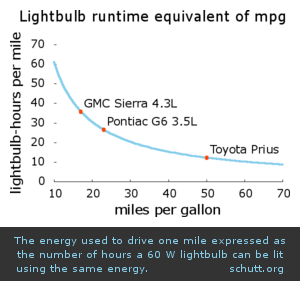Comparing cars to lightbulbs
I ran across the paper “Public perceptions of energy consumption and savings.” The authors conducted a survey to study how perceptions of energy use compares to the actual use of various appliances and transportation methods. For the appliances, they had people compare energy used to the power a 100 W lightbulb consumes in one hour. This is a convenient ranking method. It is almost the same as the way I usually think of energy used by electronics: I typically compare electrical power consumption to a 60 W incandescent bulb. For example, my computer setup (MacBook, Samsung monitor, external hard drive) is roughly equivalent to one 60 W bulb. I compare to 60 W bulbs instead of 100 W because they are more common. When I got to the point in the paper when they mention the 100 W lightbulb comparison, I stopped and did a rough estimate to compare electricity and gasoline.
A gallon of gas contains an average of 36.6 kWh. So, if a car gets 25 miles a gallon, it uses 1.46 kWh per mile. So, driving a car one mile is equivalent to keeping a 60 W light bulb on for 24.4 hours. Over one lightbulb-day per mile!
Next, I plotted this equivalency for a wide range of fuel economies, highlighting three locally common cars:
Of course, we (mostly) switched to compact fluorescent bulbs years ago. CFLs use less than a quarter of the energy of an incandescent bulb, and my car does better than 25 mpg; so, for me, driving a car a mile is more like keeping a bulb lit for over five days. Woah.
Anyway, it is an interesting paper showing that many people underestimate the energy consumption of power hungry devices, and overestimate the power consumption of small devices. It’s open access, so you should read it.
Suggested reading: “Public perceptions of energy consumption and savings” (doi:10.1073/pnas.1001509107)
